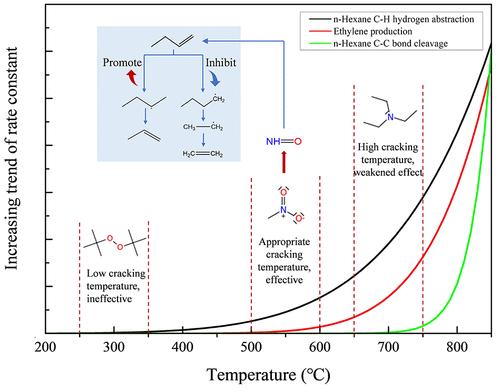当前位置:
X-MOL 学术
›
Ind. Eng. Chem. Res.
›
论文详情
Our official English website, www.x-mol.net, welcomes your feedback! (Note: you will need to create a separate account there.)
Low-Temperature-Initiated Cracking of Hydrocarbons to Produce Olefins: Simulation and Comparison of Different Initiators
Industrial & Engineering Chemistry Research ( IF 4.2 ) Pub Date : 2024-04-10 , DOI: 10.1021/acs.iecr.3c04006 Yu Ren 1, 2 , Yaoliang Mao 1 , Yudong Shen 1 , Zuwei Liao 1 , Yao Yang 1, 2 , Jingyuan Sun 1 , Binbo Jiang 1 , Jingdai Wang 1 , Yongrong Yang 1
Industrial & Engineering Chemistry Research ( IF 4.2 ) Pub Date : 2024-04-10 , DOI: 10.1021/acs.iecr.3c04006 Yu Ren 1, 2 , Yaoliang Mao 1 , Yudong Shen 1 , Zuwei Liao 1 , Yao Yang 1, 2 , Jingyuan Sun 1 , Binbo Jiang 1 , Jingdai Wang 1 , Yongrong Yang 1
Affiliation

|
Low-temperature-initiated cracking technology has significant potential to develop new hydrocarbon pyrolysis with better atomic economy and higher yields of light olefins. The impacts of three representative initiators, triethylamine (TEA), nitromethane (NM), and di-tert-butyl peroxide (DTBP), were compared. Sufficiently detailed co-cracking reaction networks of three initiators with n-hexane were obtained through an automatic reaction network generator RMG, and the corresponding steam cracking tubular reactor simulation was performed. The results showed that the initiator with a lower cracking temperature brought about a more noticeable decrease in the cracking temperature of n-hexane. Both TEA and NM increased the carbon atom conversion from n-hexane to ethylene and propylene, especially propylene. NM was more significant, while DTBP was almost ineffective. Through kinetic parameter analysis, it was found that the temperature dependence of the key reaction caused different initiator performance. NM completely cracked at an appropriate temperature where the rate constants of the hydrogen abstraction and ethylene generation had reached a high level, and the released free radicals were effective. Visual reaction network analysis revealed that NM had a strong ability to release free radicals, and these free radicals significantly adjusted the competitive reaction path to produce ethylene and propylene, resulting in the most obvious effect on improving the conversion of n-hexane and the yield of propylene. The action laws of NM described above under hydrocarbon pyrolysis conditions indicate that NM may be the most suitable initiator for low-temperature-initiated cracking of hydrocarbons among these three initiator types.
中文翻译:

低温引发烃裂解制烯烃:不同引发剂的模拟与比较
低温引发裂化技术在开发新型烃热解技术方面具有巨大潜力,具有更好的原子经济性和更高的轻质烯烃产率。比较了三种代表性引发剂三乙胺(TEA)、硝基甲烷(NM)和二叔丁基过氧化物(DTBP)的影响。通过自动反应网络生成器RMG获得了三种引发剂与正己烷的足够详细的共裂化反应网络,并进行了相应的蒸汽裂解管式反应器模拟。结果表明,裂解温度较低的引发剂使正己烷裂解温度的降低更为明显。 TEA和NM都增加了从正己烷到乙烯和丙烯,特别是丙烯的碳原子转化率。 NM 更为显着,而 DTBP 几乎无效。通过动力学参数分析发现,关键反应的温度依赖性导致引发剂性能不同。 NM在适当的温度下完全裂解,此时夺氢和乙烯生成的速率常数已达到较高水平,并且释放的自由基是有效的。可视化反应网络分析表明,NM具有很强的释放自由基的能力,这些自由基显着调整了生产乙烯和丙烯的竞争反应路径,对提高正己烷转化率和产率效果最为明显。丙烯。上述NM在烃热解条件下的作用规律表明,NM可能是这三种引发剂类型中最适合烃类低温引发裂化的引发剂。
更新日期:2024-04-10
中文翻译:

低温引发烃裂解制烯烃:不同引发剂的模拟与比较
低温引发裂化技术在开发新型烃热解技术方面具有巨大潜力,具有更好的原子经济性和更高的轻质烯烃产率。比较了三种代表性引发剂三乙胺(TEA)、硝基甲烷(NM)和二叔丁基过氧化物(DTBP)的影响。通过自动反应网络生成器RMG获得了三种引发剂与正己烷的足够详细的共裂化反应网络,并进行了相应的蒸汽裂解管式反应器模拟。结果表明,裂解温度较低的引发剂使正己烷裂解温度的降低更为明显。 TEA和NM都增加了从正己烷到乙烯和丙烯,特别是丙烯的碳原子转化率。 NM 更为显着,而 DTBP 几乎无效。通过动力学参数分析发现,关键反应的温度依赖性导致引发剂性能不同。 NM在适当的温度下完全裂解,此时夺氢和乙烯生成的速率常数已达到较高水平,并且释放的自由基是有效的。可视化反应网络分析表明,NM具有很强的释放自由基的能力,这些自由基显着调整了生产乙烯和丙烯的竞争反应路径,对提高正己烷转化率和产率效果最为明显。丙烯。上述NM在烃热解条件下的作用规律表明,NM可能是这三种引发剂类型中最适合烃类低温引发裂化的引发剂。



























 京公网安备 11010802027423号
京公网安备 11010802027423号